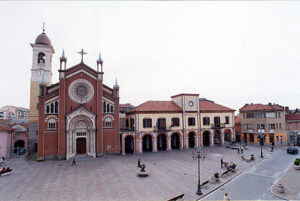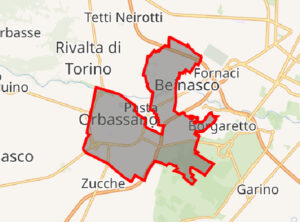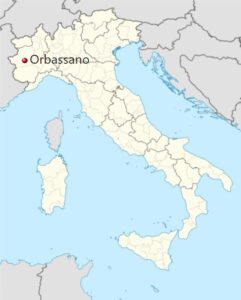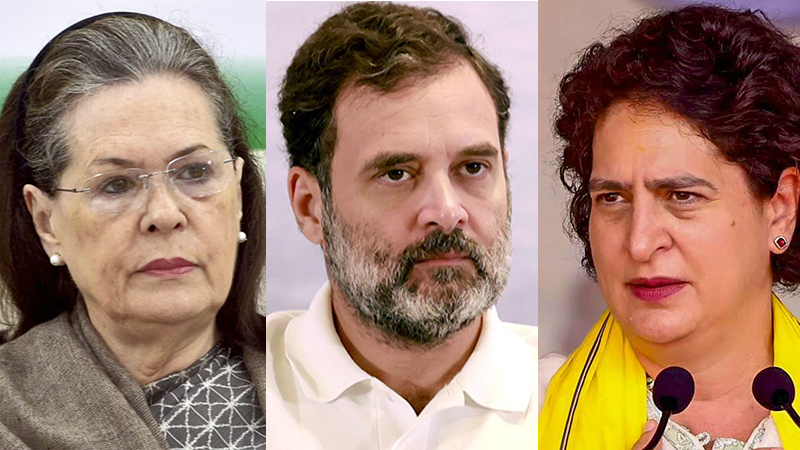When Rahul and Priyanka Gandhi arrived in Orbassano, a village near Turin, in late August 2022 for the burial of their maternal grandmother Paola Predebon, the warmth of their Italian family and the universal beauty of sacred choral music during the funeral service proved therapeutic. Sorrow was mitigated as it would if heaven and earth met.
“I had a feeling of overwhelming sadness, but the power of collective singing gave me solace,” Rahul shared in a rare interview with the Italian daily newspaper Corriere della Sera. He recalled the intimate relationship with his grandmother in the local parish that gracefully honored a loving matriarch who always found inner strength and solutions in times of adversity.
“I loved my grandma Paolina. She lived for 98 years, and I was very close to her – just as I am to my uncle Walter, the cousins, and the whole family. Actually, I was the apple of grandmother Indira’s eye, while my sister Priyanka was my Italian grandmother’s favorite,” he said.
Both Rahul and his sister Priyanka are leading a mega alliance against Indian Prime Minister Narendra Modi in the ongoing elections, in line with the legacy they are expected to carry forward.
I remember Dominique Lapierre, who enthusiastically spoke about Sonia to me for an interview years ago. The French author of City of Joy highlighted Sonia’s strengths as “intelligence, courage, and honesty”.
The native-Italian former president of the Indian National Congress collected the spiritual and political legacy of an impressive Indian family tradition and passed that flame to her children. Since the start, Sonia has shown devotion to her adoptive country and its people, never renouncing her Italian roots, “at least in terms of cuisine”, Lapierre joked around with candor. “Sonia has lasagna every week.”
To Rahul, his mother is a hero, and a role model who inspires. How could Sonia bear the grief of her husband Rajiv Gandhi’s assassination at an election campaign in 1991, and the brutal murder of her mother-in-law Indira Gandhi – the first woman Prime Minister of India – seven years earlier in 1984? Where did Sonia find inner strength to resume civic commitment and assume leadership of the Congress party? “My mother suffered, endured, and loved so much. She is a strong woman. Now she has also lost her mum,” Rahul said after his grandmother’s passing.
Talking about the Italian connection in his life, Rahul said he always admired “Italian creativity and passion”. In music, the high dramatic tones of “Mina’s voice, an extraordinary singer with a range of three octaves, and Neapolitan songs”, are his favourite, he said.
The Indian political leader is also a great soccer fan. He supports Juventus, a premier soccer club in Turin. “My heart team is Juve,” he said.

Rahul and Priyanka’s Italian roots are solid. The Indian roots are stronger. Grandma Indira wanted to find her roots in Kashmir when “she accompanied me to Dachigam National Park a few days before her tragic death to see the bears and contemplate the chinar – the oriental plane trees – the symbolic tree of Kashmir,” Rahul said.
He said of his Italian grandfather Stefano Maino, a very hardworking man like all the Mainos in the family: “I often think about him. He fought in Africa and Russia.”
As a child, Rahul always asked his granddad Stefano to tell him about the war, but he never answered. “However, one day, he showed me a helmet that he used as a vase, in which a plant was born. That helmet had belonged to his best friend, who had fallen in combat. My grandpa grew the plant to make his friend live again. Their generation rebuilt Italy after the Second World War with hard work.”
Grandpa Stefano Maino married Paolina, the daughter of an ex-carabinieri, or Italian military police, in the pretty little church of Lusiana, a scenic village at 752 meters in altitude in the Asiago Plateau towards the craggy foothills of the Italian Alps. In the Lusiana forest, the ancient Romans worshiped Diana, the goddess of the hunt and fertility.
Sonia was born in a local stone house of Lusiana, built by his father at Via Maino, where families named Maino lived for many generations. Italy’s Sikh community recently purchased Sonia Gandhi’s birthplace home. I contacted its president, Shri Sukhdev Singh Kang, for comments. “We gave ourselves a wonderful present,” he says. We Indians residing in Italy are so grateful to that great woman, and are even more proud of her as she did much for India and Indians.” Sonia’s birthplace home will become a biographical museum next year. “It will house a photographic gallery, statues, and paintings of her,” he says.
I visited Lusiana five years ago to meet Sonia’s cousin, Stefano Lupato. He was a gentleman with blue eyes who owned the Trattoria Al Colonnello da Elide in the hamlet of Vitarolo di Lusiana. I just learned that Mr. Lupato passed away.
Lupato told me that Sonia’s father worked in the construction business. In the early 1950s, he emigrated to Switzerland to look for a humble job as a bricklayer to make ends meet for his young family in the Borgo of Lusiana. “He had a strong work ethic and was so physically fit,” said Mr. Lupato.
Those were years of poverty for the Mainos, who did not own land. Before the verdant pastures surrounding the village, they had only a few cows and a stone house.
But when Sonia was in primary school, the entire family moved to Orbassano near Turin. In the meantime, her father had become a successful building contractor; he could then choose the best schools for his children,” Mr. Lupato said with pride.
Sonia attended junior high school at Istituto Maria Ausiliatrice, a Catholic boarding school run by Salesians Sisters in Giaveno, some 11 miles from Orbassano.

Recently, I met Giorgetta, a lovely lady from Turin who was Sonia’s schoolmate in Giaveno. “Sonia had a beautiful face and smile and was always cheerful. You could already glimpse the splendid woman she would become,” Giorgetta said. “At that age, there were those who had grown too quickly, those who were thin as a broomstick, those who were short and overweight. Some girlfriends had crooked teeth, and some had acne. Sonia, no! She was so beautiful, even in early adolescence,” she observed.
Sonia and Giorgetta had different teachers but ate, played together, and shared the student dorm. “We wore a black uniform: a cotton dress over mid-calf length with a white collar, socks, and shoes. When we went out in winter, it was even worse,” she said. “We wore a black coat with golden buttons and a large black beret over the wool dress.”
While outdoors, they had fun playing palla schiava (literally, slave ball). The game was to hit the opponents with the ball. The player who got hit became the “slave” or prisoner of the opposing team. “Sonia was unbeatable in this game,” Giorgetta said. “She hit so hard that it was a bit scary. In my mind, I can still picture her in the shooting position!”
Sonia was also talented beyond measure in single jump rope and double-dutch. She had fantastic eye-foot coordination and a sense of rhythm. She was fond of music and movies. “She had a TV and a record player at home, so when back to school, she would sing us the latest music hits and talk to us about the singers and actors she saw on TV,” said Giorgetta. “Sonia often sang passionately an old Mexican song, ‘Malagueña’. She could reach very high notes. I don’t know why she adored that melody.”
Giorgetta continued: “When we returned to school after a holiday break, she always showed up with a trendy haircut and beautiful clothes under that terrible beetle uniform. We all envied her quite a bit! Sure we did, but we also liked her because she was cute, lovely, and good-natured.”
Once they completed junior high school, Sonia and Giorgetta didn’t see each other for a few years. When they turned 19, the nuns organized a school reunion to reignite the spark of nostalgia, reconnect with friends, and reminisce on those cherished middle school years. “At the gathering in Giaveno, Sonia was so radiant, “Giorgetta recalled. “She was wearing a flashy men’s watch on her wrist in an era when women’s watches were small. And we were all eager to know. Finally, Sonia told us she was engaged to Rajiv Gandhi. Her men’s watch belonged to him.” Sonia had met Rajiv in a Greek cafè in Cambridge, where she studied at the Lennox Cook School. “Sonia’s words left us speechless. We no longer believed in Prince Charming; it was the truth, instead!”
After that night, Giorgetta never saw Sonia again. “The rest is history,” she said.

Today, Sonia’s children, Rahul and Priyanka, are zealous about establishing the idea of democracy on which the country was founded. “It is all about the coexistence of people, and the realization of oneself, through the non-violent search for truth,” said Rahul. “Ours is a mission. It’s an almost religious idea. It is worth more than our own life; for this reason, I am ready to die if necessary, as my grandmother and my father died. It is such a strong idea that my mother, a woman born in Italy, dedicated her entire existence to it. Well, I will defend this idea to the end.”
Rahul fights hate for love and religious harmony, as indicated by the symbol of the Congress party – a hand. “It is precisely an open hand, a sign that exists in all religions,” remarked Rahul. “Shiva, Buddha, Mahavira, Waheguru, and the Sikh deity do it. It exists in Islam, and Jesus Christ does it, too. It means: do not be afraid and don’t let fear keep you from understanding the truth.”
Rahul recognizes himself in one of his great-grandfather Jawaharlal Nehru’s phrases: “Never fear anything, never hide anything.”
Mr. Lupato defined Rahul as a good man like his father, Rajiv, and Priyanka as a charismatic lady. “I feel Priyanka will go far. She inherited personality traits from grandmother Indira — a commanding presence and a strong, bright personality. I also spot Indira’s gestures and facial expressions in her,” he said.
As Lapierre said years ago, Rahul is destined for higher things: “He will become the Prime Minister of a more modern and democratic India, as the Gandhis represent universality in a multiple and fragmented country.” – Mariella Radaelli is a senior journalist based in Milan, Italy


Leave a Reply